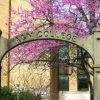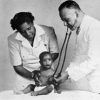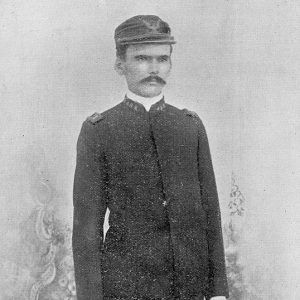calsfoundation@cals.org
Eugene Hardeman Abington (1873–1965)
Eugene Hardeman (E. H.) Abington, a physician, practiced medicine and pharmacy in Arkansas and Oklahoma for more than sixty years and wrote about his career in his 1955 book Backroads and Bicarbonate: The Autobiography of an Arkansas Country Doctor. From 1927 to 1937, he served as the first president of the Junior Agricultural School of Central Arkansas (which later became Arkansas State University–Beebe), a school established by his older brother W. H. Abington.
Born on April 20, 1873, in Des Arc (Prairie County) and raised in Beebe (White County), E. H. Abington was the second son in the farming family of William T. Abington and Mary Jane Plant Abington. He had one older sister and one older brother, William Henry Abington.
Educated in the local schools, he did not attend college but, instead, began studying medicine under Dr. James M. Gist, who was a local physician and pharmacist. In the early 1890s, he attended the Arkansas Medical School (which later became the University of Arkansas for Medical Sciences). In 1893, before obtaining his medical license in 1894, he joined his older brother’s medical practice, which was located in Russell (White County). In 1895, he returned to Beebe. In 1897, he completed his education at Marion Sims-Beaumont College of Medicine, which was located in St. Louis, Missouri.
In 1897, he married Cora L. Beam of Beebe. The couple had two children. In 1917, after his first wife’s death in 1915, he married Hope Camp Presley, who was from Argenta—now North Little Rock (Pulaski County). The couple had no surviving children.
During the Spanish-American War in 1898, he joined the Second Arkansas Volunteer Infantry, a unit that saw no service outside the United States, as an assistant surgeon under Dr. Zaphney Orto. In July 1898, he resigned from the army and resumed practicing medicine in Beebe.
In the early 1900s, he was involved in two violent episodes that occurred in Beebe. In 1905, an unnamed man shot and wounded brakeman C. F. Swain (his name was also rendered “W. F. Swain”) during a fight at the town depot. Deputized by the town marshal, Abington exchanged shots with the shooter. Wounded by gunfire from another local man, the shooter then turned his gun on himself; he claimed, as he died, to have committed multiple robberies and murders. Two other local men were wounded in the fray. In 1906, Abington, Swain, and two other men were indicted for assault with intent to kill for their roles in the shootings. Abington, who served as the chair of the White County Democratic Committee, told the press that he had “been indicted for political reasons” and that he did not “fear the result of a fair trial.” The charges against Abington and two others were dismissed. Swain was acquitted at trial.
One night in January 1907, Abington, who served as the cashier for the Bank of Beebe, stayed inside the bank in anticipation of a burglary. He shot and wounded Edward Starnes, a drunken white man, as he entered the bank through a window. In 1955, Abington recalled that he later purchased an artificial limb for Starnes, who lost part of his leg as a result of the incident.
In 1907, Abington moved to Oklahoma City, Oklahoma, to work as a pharmacist. He manufactured his own elixir, known as To-Ho-Ya, which he sold wholesale and through medicine shows. In 1917, after a warehouse fire destroyed his medicine supply, he returned to Beebe and resumed his medical practice. That same year, Abington cofounded anew Citizens’ Bank of Beebe and served as its president. Sometime in the late 1910s or early 1920s, he helped organize the Beebe Fruit and Truck Association to promote the production and marketing of the area’s strawberries and vegetables.
Abington shared his older brother’s interests in medical and vocational education. Both opposed stronger medical school admission requirements, claiming that they contributed to a rural physician shortage by raising the costs of obtaining medical degrees.
In 1929, while serving as president of the Junior Agricultural School, Abington argued that “junior colleges scattered over [the] state” would provide many with educational opportunities.
Abington died on April 22, 1965, and is buried in Beebe Cemetery.
For additional information:
Abington, E. H. Backroads and Bicarbonate: The Autobiography of an Arkansas Country Doctor. New York: Vantage Press, 1955.
“Battle with Bandits: One Is Dead.” Muskogee Times-Democrat, January 2, 1906, p. 1.
“Beebe Scene of a Bloody Fight.” Arkansas Gazette, December 30, 1905, p. 1.
Dillard, Tom. “Brothers as Physicians and Lawmakers.” Arkansas Democrat-Gazette, June 2, 2019, p. 2H.
“Four Surgeons In.” Arkansas Democrat, May 9, 1898, p. 6.
“Here and There in Arkansas.” Little River News, November 15, 1922, p. 3.
“More Schools Are Declared Needed.” Arkansas Gazette, March 29, 1929, p. 12.
“Sensation Comes from Shooting at Beebe.” Jonesboro Evening Sun, July 13, 1906, p. 1.
“Swain and Abington Free.” Arkansas Democrat, July 30, 1906, p. 1.
“Was Mistaken for Burglar.” Arkansas Democrat, January 11, 1907, p. 1.
Melanie K. Welch
Mayflower, Arkansas








Comments
No comments on this entry yet.